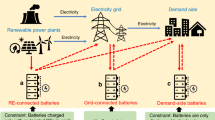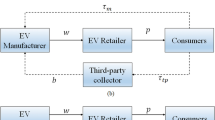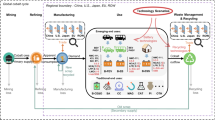Abstract
Batteries could be central to low-carbon energy systems with high shares of intermittent renewable energy sources. However, the investment attractiveness of batteries is still perceived as low, eliciting calls for policy to support deployment. Here we show how the cost of battery deployment can potentially be minimized by introducing an aspect that has been largely overlooked in policy debates and underlying analyses: the fact that a single battery can serve multiple applications. Batteries thereby can not only tap into different value streams, but also combine different risk exposures. To address this gap, we develop a techno-economic model and apply it to the case of lithium-ion batteries serving multiple stationary applications in Germany. Our results show that batteries could be attractive for investors even now if non-market barriers impeding the combination of applications were removed. The current policy debate should therefore be refocused so as to encompass the removal of such barriers.
This is a preview of subscription content, access via your institution
Access options
Subscribe to this journal
Receive 12 digital issues and online access to articles
$119.00 per year
only $9.92 per issue
Buy this article
- Purchase on Springer Link
- Instant access to full article PDF
Prices may be subject to local taxes which are calculated during checkout




Similar content being viewed by others
References
Technology Roadmap Energy Storage (International Energy Agency, 2014).
Battke, B. & Schmidt, T. S. Cost-efficient demand-pull policies for multi-purpose technologies—the case of stationary electricity storage. Appl. Energy 155, 334–348 (2015).
Nykvist, B. & Nilsson, M. Rapidly falling costs of battery packs for electric vehicles. Nature Clim. Change 5, 329–332 (2015).
Krajačić, G. et al. Feed-in tariffs for promotion of energy storage technologies. Energy Policy 39, 1410–1425 (2011).
Schmidt, T. S. Low-carbon investment risks and de-risking. Nature Clim. Change 4, 237–239 (2014).
del Río, P. & Gual, M. A. An integrated assessment of the feed-in tariff system in Spain. Energy Policy 35, 994–1012 (2007).
Energie-Info Erneuerbare Energien und das EEG: Zahlen, Fakten, Grafiken der EEG-induzierten Zahlungsströme (Bundesverband der Energie- und Wasserwirtschaft e.V., 2015).
Eyer, J. & Corey, G. Energy Storage for the Electricity Grid: Benefits and Market Potential Assessment Guide (Sandia National Laboratories, 2010).
Zucker, A., Hinchliffe, T. & Spisto, A. Assessing Storage Value in Electricity Markets: A Literature Review (European Commission Joint Research Centre, 2013).
Fitzgerald, G., Mandel, J., Morris, J. & Touati, H. The Economics of Battery Energy Storage (Rocky Mountain Institute, 2015).
Renewables and Electricity Storage, A Technology Roadmap for REmap 2030 (International Renewable Energy Agency, 2015).
Manz, D., Piwko, R. & Miller, N. Look before you leap. IEEE Power Eng. Mag. 10, 75–84 (2012).
Denholm, P. et al. The Value of Energy Storage for Grid Applications (National Renewable Energy Laboratory, 2013).
Akhil, A. A. et al. DOE/EPRI 2013 Electricity Storage Handbook in Collaboration with NRECA (Sandia National Laboratories, 2013).
Kaun, B. Cost-Effectiveness of Energy Storage in California: Application of the Energy Storage Valuation Tool to Inform the California Utility Commission Proceeding R. 10-12-007 (Electric Power Research Institute, 2013).
Brealey, R. & Myers, S. Principles of Corporate Finance (McGraw-Hill, 1981).
Sioshansi, R., Denholm, P. & Jenkin, T. Market and policy barriers to deployment of energy storage. Econ. Energy Environ. Policy 1, 47–63 (2012).
Culver, W. J. High-value energy storage for the grid: a multi-dimensional look. Electr. J. 23, 59–71 (2010).
Sioshansi, R., Denholm, P., Jenkin, T. & Weiss, J. Estimating the value of electricity storage in PJM: arbitrage and some welfare effects. Energy Econ. 31, 269–277 (2009).
Wilson, D. & Hughes, L. Barriers to the development of electrical energy storage: a North American perspective. Electr. J. 27, 14–22 (2014).
Bhatnagar, D. & Loose, V. Evaluating Utility Procured Electric Energy Storage Resources: A Perspective for State Electric Utility Regulators A Study for the DOE Energy Storage Systems Program (Sandia National Laboratories, 2012).
Schoenung, S. M. & Eyer, J. Benefit/Cost Framework for Evaluating Modular Energy Storage (Sandia National Laboratories, 2008).
EPRI-DOE Handbook of Energy Storage for Transmission & Distribution Applications (Electric Power Research Institute, 2003).
Sharpe, W. F. Capital asset prices: a theory of market equilibrium under conditions of risk. J. Finance 19, 425–442 (1964).
Dunn, B., Kamath, H. & Tarascon, J.-M. Electrical energy storage for the grid: a battery of choices. Science 334, 928–935 (2011).
Renewables 2015 Global Status Report (Renewable Energy Policy Network for the 21st Century, 2015).
KfW-Programm Erneuerbare Energien “Speicher” (KfW Bankengruppe, 2015).
Waissbein, O., Glemarec, Y., Bayraktar, H. & Schmidt, T. S. Derisking Renewable Energy Investment (United Nations Development Programme, 2013).
Ebner, M., Marone, F., Stampanoni, M. & Wood, V. Visualization and quantification of electrochemical and mechanical degradation in Li ion batteries. Science 342, 716–720 (2013).
He, X., Delarue, E., D’haeseleer, W. & Glachant, J.-M. A novel business model for aggregating the values of electricity storage. Energy Policy 39, 1575–1585 (2011).
Taylor, J. A. Financial storage rights. IEEE Trans. Power Syst. 30, 997–1005 (2015).
Energy and Climate Change World Energy Outlook Special Report (International Energy Agency, 2015).
Agnew, S. & Dargusch, P. Effect of residential solar and storage on centralized electricity supply systems. Nature Clim. Change 5, 315–318 (2015).
Graffy, E. & Kihm, S. Does disruptive competition mean a death spiral for electric utilities? Energy Law J. 35, 1–44 (2014).
Bontrup, H.-J. & Marquardt, R.-M. Die Zukunft der Großen Energieversorger (Greenpeace e.V., 2015).
Brown, L. et al. An inventory of nitrous oxide emissions from agriculture in the UK using the IPCC methodology: emission estimate, uncertainty and sensitivity analysis. Atmos. Environ. 35, 1439–1449 (2001).
Vose, D., Koupeev, T., Van Hauwermeiren, M., Smet, W. & van den Bossche, S. Help File for ModelRisk Version 5 Vose Software (2007); http://www.vosesoftware.com/ModelRiskHelp/index.htm#Modeling_expert_opinion/Distributions_used_in_modeling_expert_opinion.htm
Damodaran, A. Strategic Risk Taking: a Framework for Risk Management (Wharton School Publishing, 2008).
Kerber, G. Aufnahmefähigkeit von Niederspannungsverteilnetzen für die Einspeisung aus Photovoltaikkleinanlagen (Technische Universität München, 2011).
Hille, C. et al. Technische und Wirtschaftliche Potenziale von Speichersystemen in Verteilungsnetzen (P3 Energy; RWTH Aachen, 2015).
Acknowledgements
We gratefully acknowledge the financial support provided by EnergieSchweiz (project ID 131916726). We also would like to thank V. Hoffmann, J. Kölbel and P. Thömmes for their support for and valuable inputs to this study.
Author information
Authors and Affiliations
Contributions
T.S.S., A.S. and B.B. designed the research, A.S., M.D.B. and J.H.C. developed the model and carried out the data search, A.S. and T.S.S. carried out the analyses, A.S. and T.S.S. wrote the paper.
Corresponding author
Ethics declarations
Competing interests
The authors declare no competing financial interests.
Supplementary information
Supplementary Information
Supplementary Figures 1–4, Supplementary Tables 1–4, Supplementary Notes 1–4, Supplementary References. (PDF 604 kb)
Rights and permissions
About this article
Cite this article
Stephan, A., Battke, B., Beuse, M. et al. Limiting the public cost of stationary battery deployment by combining applications. Nat Energy 1, 16079 (2016). https://doi.org/10.1038/nenergy.2016.79
Received:
Accepted:
Published:
DOI: https://doi.org/10.1038/nenergy.2016.79
This article is cited by
-
Computation and Optimization of BESS in the Modeling of Renewable Energy Based Framework
Archives of Computational Methods in Engineering (2024)
-
Coupled power generators require stability buffers in addition to inertia
Scientific Reports (2022)
-
Life-Cycle Economic Evaluation of Batteries for Electeochemical Energy Storage Systems
Journal of Electrical Engineering & Technology (2021)
-
The emergence of cost effective battery storage
Nature Communications (2019)
-
Impacts of self-generation and self-consumption on German household electricity prices
Journal of Business Economics (2019)



